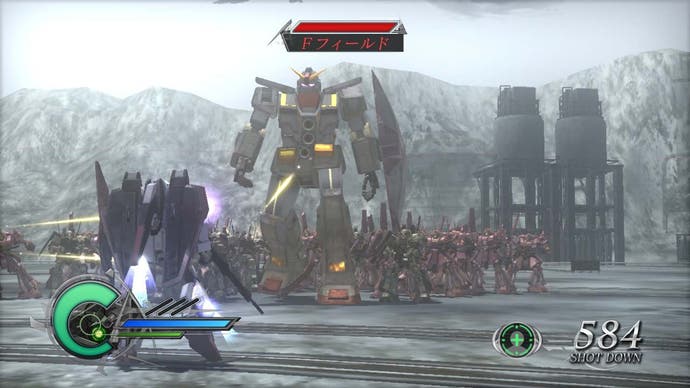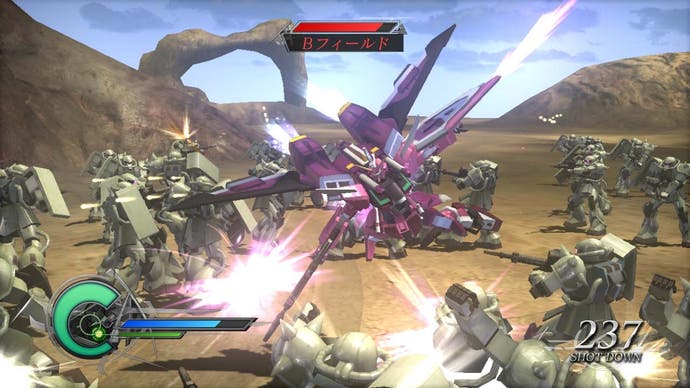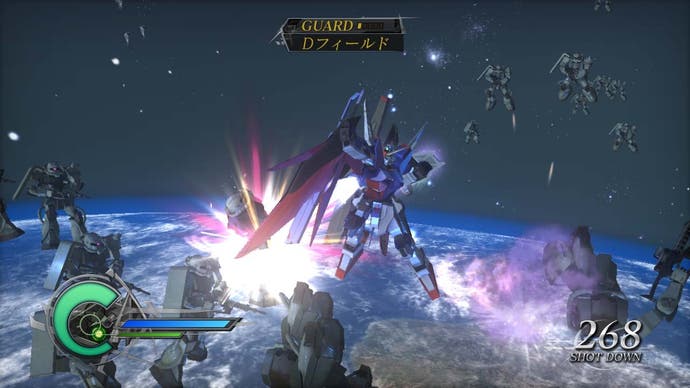Gundam Musou 2
Gundam, this is good.
Fighting the corner of KOEI's Dynasty Warriors/Musou series isn't exactly a fashionable cause. It's not like they're cel-shaded, or full of obtuse philosophising, or surreal humour (although there is something pretty strange about the haircuts and voice-acting). But, especially in the case of Gundam Musou, it is a worthy cause.
Except in Japan, Gundam Musou is one of the most cruelly overlooked games of recent years, using the various Gundam universes as a pretext for injecting a heightened sense of dynamism to the Dynasty Warriors battlefield formula, taking it to new heights of brilliance. Gundam Musou 2 isn't quite so paradigmatic, but it does build on its predecessor to take that formula to even greater extremes, and it offers so much content that you'll probably still be unlocking stuff this time next year.
If you've never played the first game, or indeed any other Warriors game, start here. It is the apogee of KOEI's distinctive brand of action strategy: shape the course of battle by ploughing through hundreds of enemy drones, face climactic encounters with enemy officers, and implement real-time strategy through immediate action, chaining combos together, and darting about the battlefield to meet each new threat. And do so with a speed and fluidity that outstrips any of the other Warriors titles (even Dynasty Warriors 6). If you couldn't care less about Gundam, then it doesn't matter because you can just concentrate on the action. If you could care less about Gundam, then you will be well catered for because this game contains more mobile suits than you could shake a big robotic stick at (unless you're an American and think 'could care less' means 'couldn't care less', in which case, as above, it doesn't matter).

If you're one of that small band of devotees who have been patiently awaiting a sequel ever since they racked up hundreds of hours on the first game, you might be wondering what the sequel does differently. First, there are the changes on the field of battle. The one that the people at KOEI seem keenest to promote is that there are now even bigger robots that appear occasionally, but actually they don't really add much at all apart from interrupting the flow of the game with some mildly irritating and lengthy boss battles. They don't really pop up too often to ever get truly annoying though, and, who knows, some people might actually enjoy them. A more welcome change, and probably the most significant, is that your boosters now last for longer, allowing you to use them to chain your combos into increasingly lengthy waves of destruction - making you feel even more empowered, and opening up new strategic options.
The other changes to the way the action works are relatively minor: stalemates with enemy officers are now resolved by a quick-time-style sequence of button presses instead of simple button mashing - and it works so well that you wonder why KOEI didn't implement it before. And Musou attacks no longer escalate with each filled Musou bar; instead each filled bar extends the duration of the Musou attack, and each mobile suit has two Musou attacks - one in the air and one on the ground. If none of that means anything to you, just understand this: it works better than before.

Gundam Musou 2 also makes changes sway from the battlefield, by drawing on an even wider range of Gundam sources than in the first game. By unlocking new parts over the course of the game you can create new mobile suits to take the playable number up to a staggering 62 (compared to 19 in the first game). Gundam geeks will now get to spazz out over suits from Char's Counterattack, Victory Gundam, and Gundam SEED Destiny, on top of all the series featured in the first game. Or they might spit with rage that their own favourite Gundam imprint hasn't been included - but if you're the kind of person who gets hung up on whether Turn A is better than Gundam Wing, you're probably missing the point of Gundam Musou. It is not, really, a Gundam game as much as it is a Warriors game, and if you're looking for some canonical sense of authenticity, then perhaps you should stick to the cartoons.
In any case, the real difference between Gundam Musou 2 and the first game is in its size and scope. The first game contained an official mode and original mode, which each featured five or six missions for each of the 22 characters. Its sequel contains an original mode, which is similar to the first game, and a mission mode, which contains nearly 100 missions per character - missions that allow you to build up friendships with other pilots; missions that allow you to unlock new equipment; missions that develop the story; and missions that are just free to play; while between missions you exchange emails with other pilots and conduct research into new technology. It is a staggering amount of content, and in terms of value for money alone, Gundam Musou 2 eclipses most other games, with enough to keep devoted fans occupied well beyond a hundred hours.

That's not to say that game length is a reliable measure of excellence - of course it's not. And some people will no doubt want to criticise Gundam Musou 2 for a perceived lack of originality, because at its heart this is the same game as before. But on those grounds you'd also have to criticise every iteration of FIFA or PES, or Halo, or Resistance. For anyone who has found themselves fifty hours into the first game and still wanting more, Gundam Musou 2 delivers it, with flourish. If you play through this avalanche of new content and you still don't find yourself warming to KOEI's Warriors series, then you can probably forget about ever doing so, because Gundam Musou 2 is absolutely the best in its class. Here's hoping it won't be quite so criminally overlooked as the first game.
